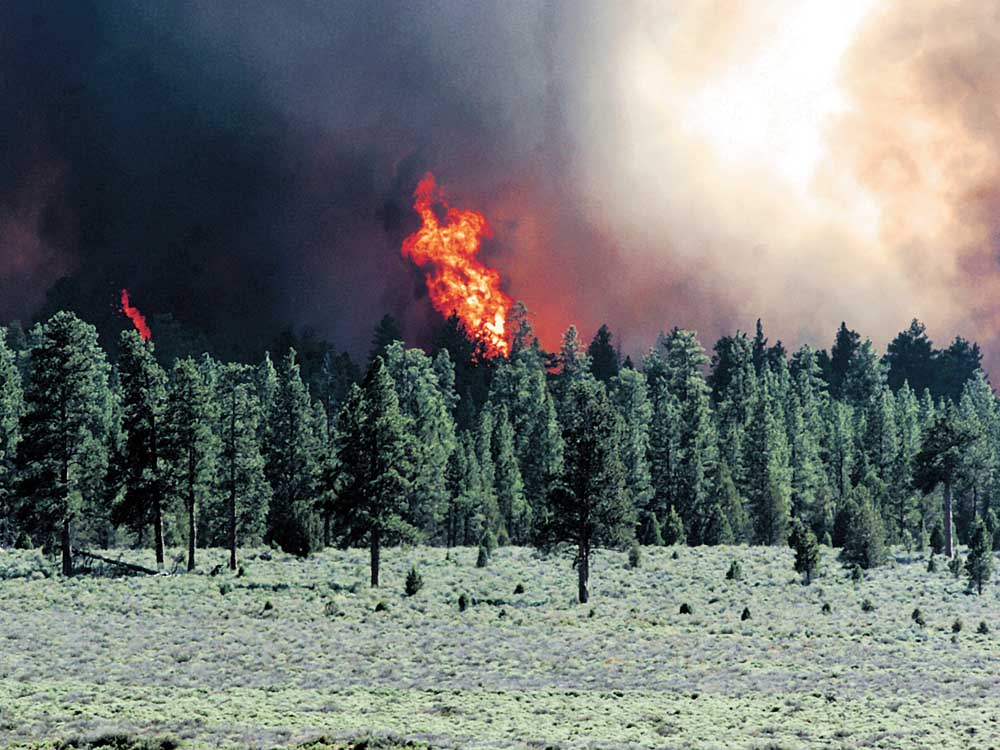Central Oregon fire season differs from Western Oregon, California
Published 3:57 pm Thursday, September 10, 2020

- Flames from the Two Bulls Fire burns west of Tumalo in 2014.
As much of California and western Oregon suffers from another devastating wildfire season, Central Oregonians have watched with a mix of sympathy and concern, wondering if the same problems could occur in their backyard.
Alex Robertson, fire and aviation staff officer for Central Oregon Fire Management Service, said Central Oregonians need to be vigilant to prevent wildfire, but adds that conditions here don’t necessarily compare to other areas in the Western U.S.
What’s different? To begin, looking at California, most of the wildfires in the Golden State are occurring in areas of thick brush and dry grass — vegetation that can quickly ignite and grow out-of-control before fire officials have time to respond. That type of fuel is less fire-resistant than a ponderosa forest, predominant in Central Oregon, where the trees have a naturally fire-resistant bark.
“A lot of those fires are in a lower elevation, so that is going to mean hotter and drier areas and with a fuel type that is really difficult to keep up with,” said Robertson. “Brush or grass just creates fire behavior and growth that we generally don’t see up here.”
California’s rampant urban growth presents a second big difference between the states, said Robertson. With little acreage left to build upon, California developers have pushed the suburbs into the hillsides and in canyons where fires are more likely to strike.
When wildfires race up steep canyons in Santa Barbara, Ventura, Sonoma, and other counties in California, the result is often homes destroyed and lives lost. Oregon has partly avoided this fate with tighter controls on urban growth, due in part to legislation championed in the early 1970s by Gov. Tom McCall, who sought to avoid the problems caused by urban sprawl afflicting other parts of the country.
This year, more than 2.2 million acres have burned in California, making it the largest wildfire season in that state’s history, according to state fire agency Cal Fire. Until last week the number of acres burned in Oregon this year was 170,000. Devastating fires that tore through Oregon this week increased that number to more than 805,000 acres, according to the Oregon Office of Emergency Management.
Unusual weather has also played a part in this year’s destruction fire season. Over the course of a week in mid-August, more than 12,000 lightning strikes were recorded in Northern California, sparking hundreds of fires and overwhelming CalFire’s ability to respond effectively. Strong winds have also fanned the flames in California.
“What is going on down there is a perfect storm,” said Robertson.
Prescribed burns account for another difference between the states, says Larry O’Neil, an associate professor at the College of Earth, Ocean, and Atmospheric Sciences at Oregon State University. Oregon may be doing a better job at conducting these burns, he said.
“In at least the past decade, Oregon has utilized prescribed burning on many more acres compared with California,” said O’Neil, who also serves as the Oregon state climatologist. “This year, California has reached a memorandum of understanding between various agencies to do more prescribed burning, but it is unclear whether this will occur in practice.”
Oregon’s consistent approach to prescribed burns has helped the state in previous years, but parts of the state have still been overwhelmed by fire this year. Much of the devastation has occurred in Western Oregon, where forests are denser compared to the east side of the Cascades.
Central Oregon is not immune to fires. In 2014 the Two Bulls fire burned 6,908 acres in an area west of Bend, mainly on private timberland. In 1990 the Awbrey Hall Fire burned 3,350 acres and destroyed 22 homes. Fire officials have since taken a proactive approach to preventing fires in the area, including aggressive tree thinning in the Deschutes National Forest west of Bend.
Wherever fires do occur, they tend to sap resources for other parts of the country. So a bad fire season in California means fewer engines, planes, and personnel available to fight fires in Oregon. With hundreds of fires burning across the West in recent weeks, personnel and equipment needs are stretched beyond capacity. When this happens, small fires can get out of control quickly.
While differences may exist between the two states, O’Neil says global warming is impacting much the Western U.S., drying out forests and creating conditions that make areas more prone to wildfire.
“We have already observed changes in timing of and amount of snowmelt and bigger swings between precipitation in wet and dry years,” said O’Neil. “In future dry years, moisture deficits stress trees, making them drier, less healthy, more prone to insect infestations, and ultimately more flammable.”
Reduced snowpack in general in the Cascades will lead to soil moisture stress, making forests even more vulnerable to extensive wildfires while changing the lifespan and composition of forests, O’Neil added.
There’s a little bit of luck involved too, regarding where wildfires break out, said O’Neil. Storms that pelted Northern California with thousands of lightning bolts last month were a rare occurrence, but could also happen in Oregon.
“Fortunately, lightning activity throughout Oregon has been significantly less than normal this summer due to a weak summer monsoon season,” said O’Neil. “We also haven’t experienced a long enough stretch of abnormally hot weather following lightning starts. This is a matter of good fortune.”








